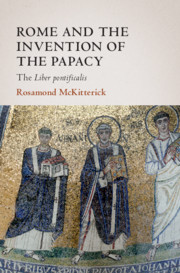Book contents
- Rome and the Invention of the Papacy
- The James Lydon Lectures in Medieval History and Culture
- Rome and the Invention of the Papacy
- Copyright page
- Dedication
- Contents
- Maps
- Preface
- Abbreviations
- 1 The Liber pontificalis
- 2 The Liber pontificalis and the City of Rome
- 3 Apostolic Succession
- 4 Establishing Visible Power
- 5 Bishop and Pope
- 6 Transmission, Reception, and Audiences
- Conclusion
- Bibliography
- Index of Manuscripts
- General Index
5 - Bishop and Pope
Published online by Cambridge University Press: 04 June 2020
- Rome and the Invention of the Papacy
- The James Lydon Lectures in Medieval History and Culture
- Rome and the Invention of the Papacy
- Copyright page
- Dedication
- Contents
- Maps
- Preface
- Abbreviations
- 1 The Liber pontificalis
- 2 The Liber pontificalis and the City of Rome
- 3 Apostolic Succession
- 4 Establishing Visible Power
- 5 Bishop and Pope
- 6 Transmission, Reception, and Audiences
- Conclusion
- Bibliography
- Index of Manuscripts
- General Index
Summary
So far in this book I have highlighted particular themes in the Liber pontificalis presented by the authors of the sixth-century portion of the narrative and its continuations. These can be summarized as follows: the transformation of the city of Rome in imagination and text; the construction of a distinctively papal and apostolic past in early Christian Rome; and the visible display of papal power in Rome in the building and embellishment of churches in honour of the saints. All these themes combine to convey a very particular understanding of the history of the popes and of the Christian city of Rome. There is no inevitability in the development of the papacy. All the papal building projects, for example, constructed particular places for collective and regular Christian observance and devotion. They were spaces which acted as the venues where many Christians gathered, that belonged to their communities, were associated with particular saints who were part of the history of the city, and were where the institutionalized liturgical rituals of belonging took place. I have explored the way the authors exploited existing knowledge and reframed it, shaping the way subsequent readers would remember and understand the popes’ role in the city and in relation to its Christian inheritance. Indeed, I have suggested that the Liber pontificalis needs to be seen as complementing and corroborating both the contemporaneous visual and material evidence and other categories of written text. Not only that: the narrative offers a persuasive, chronologically ordered framework into which the other categories of text and material evidence could be fitted and their credentials understood. We cannot read the Liber pontificalis in isolation from these other texts and the wider physical context whose existence the Liber pontificalis implies. This is particularly the case for the liturgy, the pope’s definitive statements about Christian orthodoxy, and his interventions in canon law.
- Type
- Chapter
- Information
- Rome and the Invention of the PapacyThe <I>Liber Pontificalis</I>, pp. 132 - 170Publisher: Cambridge University PressPrint publication year: 2020

